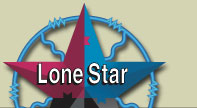General-
City is know as the "Resaca City". A picturesque resaca, 400 feet wide,
flows through the town, which is the main canal of a large irrigation system. Only
eight miles from the Mexican border, San Benito was first named Diaz, for Mexico's
president, because the people of the area were predominantly of Mexican ancestry.
Anglo settlers did not arrive until 1906, after the completion of the first irrigation
system.
Prior to the construction of the irrigation systems, the region was an arid wilderness
covered with mesquite, cactus and brush. As a result of irrigation, the city, as
well as all of the Lower Rio Grande Valley, developed an extensive agricultural business.
The mild winter climate allows crops to grow year round, not to mention the
colorful flowers and native trees.
A birder's paradise.
Note the name of the streets, particularly in the central part of town.
Generally, north and streets are named after Texas heroes; east and west streets for early
community leaders. In other areas of the city, streets are named after landmarks and
notable figures in Mexican and American history.
Colonel Sam A. Robertson, founder of the city, promoted and built the San Benito and
Rio Grande Valley Railroad to provide an efficient transportation system for shipping farm
products. Because of the intricate network of lines and spurs, the railroad was
commonly referred to as the "Spiderweb Railroad".
Hayrides offered year round every weekend at 1220 West Business U.S. 77. For
schedule and information, call 956/ 399-7888.
Historical markers are found within the city and area. For information on events,
accommodations and dining, contact the Chamber of Commerce at 210 East Heywood, or call
956/ 399-5321.
Los Indios Free Trade Bridge -
The bridge is centrally located about ten miles south of Harlingen / San Benito on F.M.
509 at Los Indios on the U.S. / Mexican border.
Narcisco Martinez Cultural Arts Center -
Dedicated to the preservation, promotion and development of Mexican heritage in visual
arts, music, theater, dance, film and literary work. Named for Narcisco Martinez,
who is considered the "Father of the Texas Mexican Conjunto" music.
Open Saturday 10 a.m. - 2 p.m. At 225 East Stenger.
For exhibit / event schedule, call 956/ 361-0110.


